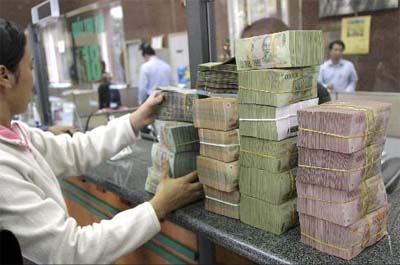However, we should not overestimate this possibility. The Government wants to avoid economic recession on the one hand and avoid inflation on the other, so it will have to wield monetary policies flexibly.
Monetary policies can take anywhere from three months to two years to have their intended effect. In Vietnam, I think, it will be take around six months to one year. However, in the midst of this current economic downturn, businesses are struggling and people may be more cautious, so the effects could take longer to manifest.
With regard to the relationship between money supply and inflation, there are two points to emphasise. Firstly, such a huge increase to the money supply in the second quarter, which is meant specifically to boost production, may not have exactly the intended results. There is no doubt that the money will be fully disbursed, and it is likely that part of the money will be used for investment in sectors other than those that expressly create real goods and services. If production does not increase commensurate with the increase in the money supply, then we should expect inflation.
Secondly, in recent years urban dwellers have increased their income thanks to transactions in the real estate and stock markets. This is a self-perpetuating trend and will increase consumption demand. The discrepancy between the increased demand and the relatively unchanged supply will obviously result in inflation.
In light of the recent increase to the money supply, if the Government wants to keep the inflation rate at 7 to 8 per cent this year, the credit growth rate should be limited to 30 per cent. However, the credit growth rate during the first six months of 2009 was already 17 per cent. This partially explains why banks are offering higher deposit interest rates. Because interest rates are subsidized under the Government’s stimulus package, banks can raise interest rates to nearly the State Bank of Vietnam’s ceiling for interest rates while still remaining profitable. There is also pressure on the USD-VND exchange rate. If interest rates are too low, banks will be unable to mobilize capital. Furthermore, the expectation of high inflation will be a self-fulfilling prophecy, resulting in increased interest rates.
In other words, the interest rate adjustments are quite normal given the circumstances; it does not mean a liquidity crisis. Nonetheless, the Government must walk a narrow line, making sure to boost economic activity without aggravating the inflation rate. Additionally, policymakers should identify an exit strategy so that the Government can loosen its grip on the economy once recovery is more certain. This exit strategy might come in the form of adjustments to the exchange rate, the interest rate, the monetary supply, the speed of the stimulus packages’ disbursement, Government bonds, or the removal of the ceiling interest rate.
In terms of the exchange rate, there is clearly downward pressure on the Vietnam dong because the expectation of inflation in Vietnam is higher than in other countries. The trade deficit has decreased considerably since 2007, but it remains high; it will likely account for 6 to 7 per cent of the country’s GDP this year.
Meanwhile, capital inflows of foreign direct investment and remittances are not sufficient to cover this deficit. According to some international organizations, the balance of payments could drop by VND 1 to 2 billion. In addition, due to the initial economic recovery, production in the short term will increase.
Yet these do not fully explain the current shortage of US dollars that businesses are facing. Vietnam’s foreign currency reserve is USD20 billion, but in the world economy, the US dollar is depreciating.
Why then is there a shortage of US dollars? First of all, Vietnam’s foreign exchange market is fragmented, consisting of black markets as well as official markets. Businesses and individuals prefer to keep their own capital in US dollars, deforming the market and creating a dollar shortage. To combat this shortage, a number of measures should be adopted. First and foremost, market confidence must be regained. If not, the market will become even more fragmented, as people will hoard dollars.
Secondly, commitments regarding the exchange rate must be made before any adjustments are made. This will help businesses anticipate exchange rate fluctuations and better prepare their business plans, which are particularly important as Vietnamese businesses do not have the tools to manage risks caused by exchange rate fluctuation. Furthermore, exchange rate policies should be managed more flexibly, and the Government’s interventions should be imposed at the correct time. Finally, market discipline must be ensured.
Lastly, China’s stimulus package will have an effect on Vietnam’s economy. China’s government has unveiled its stimulus package decisively and resolutely. Its commitment to its policies has provided confidence throughout the whole market. Under China’s stimulus package, the beneficiaries are clearly identified, and supervision is quite strict. Moreover, there is close coordination between central and local authorities, and possible risks, such as corruption, are accounted for.
China also was in a better position to undertake its stimulus package. China has a huge population and, therefore, greater domestic demand. Although its exports have plummeted, domestic demand is strong enough to bolster a high growth rate. Moreover, the macroeconomy has been much more stable than Vietnam’s. Their budget prior to the stimulus packages was balanced, which has helped keep inflation and budget deficits in check.
China, which some economists say will surpass Japan this year as the largest economy in Asia and the 2nd largest in the world, is inextricable from the fate of SE Asia. Chinese imports are on the decline, but imports from ASEAN countries, mainly from Indonesia, Malaysia, Philippines, Singapore, and Thailand, are rising. Vietnam could take part in the profit, too. Demand for finished products in China is increasing creating good opportunities for the whole region; however, Vietnam will have to improve the quality of its finished goods. Its quality lags behind that of other regional countries like Thailand.

